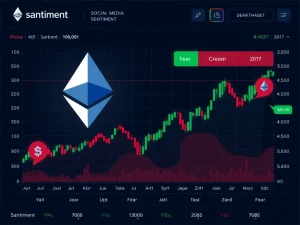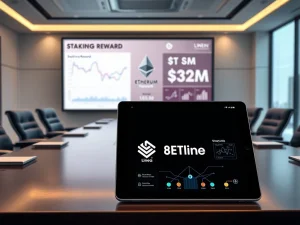RESOLV Token Explodes 11% as Groundbreaking Fee Switch Propels Market Cap to $47M

In the dynamic world of decentralized finance (DeFi), innovation often sparks significant market movements. Recently, the RESOLV token made headlines with an impressive short-term surge, pushing its market capitalization to new heights. This isn’t just another price pump; it’s a clear signal of investor confidence in a strategic shift within the protocol’s economic model.
Understanding the RESOLV Token’s Ascent
On July 25, 2025, the RESOLV token experienced a remarkable jump, surging over 11% in value. This rapid appreciation propelled its total market cap to an impressive $47 million. The surge wasn’t a random occurrence; it directly coincided with the project’s pivotal announcement: the activation of its protocol fee switch. This move has been widely interpreted by the market as a strong positive catalyst, highlighting how internal governance decisions can profoundly impact a token’s valuation.
The immediate market reaction underscores a growing trend in the crypto space where fundamental utility and transparent governance play a crucial role in driving value. Investors are increasingly looking beyond mere speculation, focusing on projects that offer tangible benefits and sustainable economic models.
The Power of the Protocol Fee Switch: A Game Changer?
What exactly is a protocol fee switch, and why is it so significant for RESOLV? At its core, this mechanism is designed to redistribute a portion of transaction fees generated by the protocol directly to RESOLV stakers. This isn’t just about sharing revenue; it’s about aligning the interests of token holders with the long-term success and operational efficiency of the RESOLV ecosystem.
Here’s how this mechanism aims to enhance value and foster sustainability:
- Enhanced Value Retention: By directing fees back to stakers, the protocol creates a direct incentive for holding and staking RESOLV tokens, reducing immediate selling pressure.
- Incentivized Participation: Long-term holders are rewarded for their commitment, fostering a more stable and engaged community around the protocol.
- Deflationary Mechanism: While not strictly burning tokens, the redistribution of fees can act as a pseudo-deflationary force by encouraging staking and reducing circulating supply available for sale.
This strategic shift marks a significant evolution in RESOLV’s tokenomics, moving towards a more robust and self-sustaining model that prioritizes its community.
RESOLV’s Market Cap Momentum: A Direct Impact Story
The immediate and tangible impact of the fee switch activation was evident in RESOLV’s market cap surge. Before the announcement, the market capitalization stood at approximately $42 million. Within a single reporting period, this figure climbed to $47 million, showcasing the market’s rapid absorption and positive interpretation of the update.
This growth wasn’t fueled by external macroeconomic factors or broad sector trends; it was primarily driven by on-chain activity and the direct implications of a governance decision. This highlights a crucial aspect of decentralized finance: the power of internal protocol adjustments and transparent governance in influencing investor confidence and market valuation. The 11% gain is a testament to the market’s belief in the long-term potential of RESOLV’s revised economic model.
Broader Implications for DeFi: A New Blueprint?
RESOLV’s recent success story aligns perfectly with broader trends and evolving priorities within the DeFi landscape. The focus is increasingly shifting towards:
- Token Utility: Projects that offer clear, tangible utility for their native tokens are gaining traction. RESOLV’s fee-sharing model exemplifies this by directly rewarding tokenholders for their participation.
- Revenue-Sharing Mechanisms: Protocols that share a portion of their generated revenue with their community are proving more effective at retaining user bases and market share.
- Sustainable Ecosystems: The push for self-sustaining models, where tokenholders are incentivized to contribute to network security and governance, is becoming paramount.
Unlike traditional assets, whose values are often influenced by rankings or indices, RESOLV’s growth appears to stem from direct utility. This emphasizes the importance of a self-sustaining ecosystem where tokenholders are rewarded for contributing to network security and governance. The absence of external macroeconomic or sector-specific factors in the news suggests the surge is attributable to internal protocol adjustments, underscoring the role of governance transparency in DeFi projects.
What This Means for the Cryptocurrency Landscape
The RESOLV update is a compelling case study in the evolving cryptocurrency landscape, specifically highlighting the growing emphasis on stakeholder incentives in blockchain ecosystems. By redistributing fees, the project seeks to create a virtuous cycle of participation and value creation. This model could potentially serve as a blueprint for other DeFi protocols aiming to strike a balance between scalability, sustainability, and community engagement.
As the DeFi space matures, projects that demonstrate clear value accrual mechanisms for their token holders, coupled with transparent and effective governance, are likely to stand out. RESOLV’s move sets a precedent for how protocols can foster loyalty and long-term commitment from their communities, paving the way for more robust and resilient decentralized economies.
Conclusion
RESOLV’s impressive 11% surge and market cap increase to $47 million, driven by the activation of its protocol fee switch, marks a significant milestone for the project. This strategic move not only enhances value for RESOLV token holders but also sets a compelling example for the broader DeFi ecosystem. By aligning incentives and prioritizing community participation, RESOLV is positioning itself as a leader in building a sustainable and rewarding decentralized future. The market’s enthusiastic response underscores the power of strong tokenomics and transparent governance in driving real-world value in the crypto space.
Frequently Asked Questions (FAQs)
Q1: What caused the recent surge in RESOLV token’s price?
The RESOLV token’s recent surge of over 11% was primarily caused by the activation of its protocol fee switch, a mechanism designed to redistribute a portion of transaction fees directly to RESOLV stakers, thereby enhancing value and incentivizing long-term participation.
Q2: What is a protocol fee switch?
A protocol fee switch is a built-in mechanism within a blockchain protocol that allows a portion of the transaction fees generated by the network to be redirected, often to token holders who stake their assets, thereby aligning their interests with the protocol’s success and providing direct utility.
Q3: How does the fee switch benefit RESOLV token holders?
The fee switch benefits RESOLV token holders by directly redistributing a portion of the protocol’s transaction fees to them when they stake their tokens. This enhances value retention, incentivizes long-term holding, and acts as a mechanism to reduce selling pressure on the token.
Q4: What is RESOLV’s current market capitalization after the surge?
Following the activation of the protocol fee switch and the subsequent surge, RESOLV’s market capitalization increased from approximately $42 million to $47 million.
Q5: How does RESOLV’s growth strategy align with broader DeFi trends?
RESOLV’s growth strategy, particularly its emphasis on token utility and revenue-sharing mechanisms through the fee switch, aligns strongly with broader DeFi trends that prioritize creating self-sustaining ecosystems where tokenholders are rewarded for contributing to network security and governance, fostering user retention and market share.








